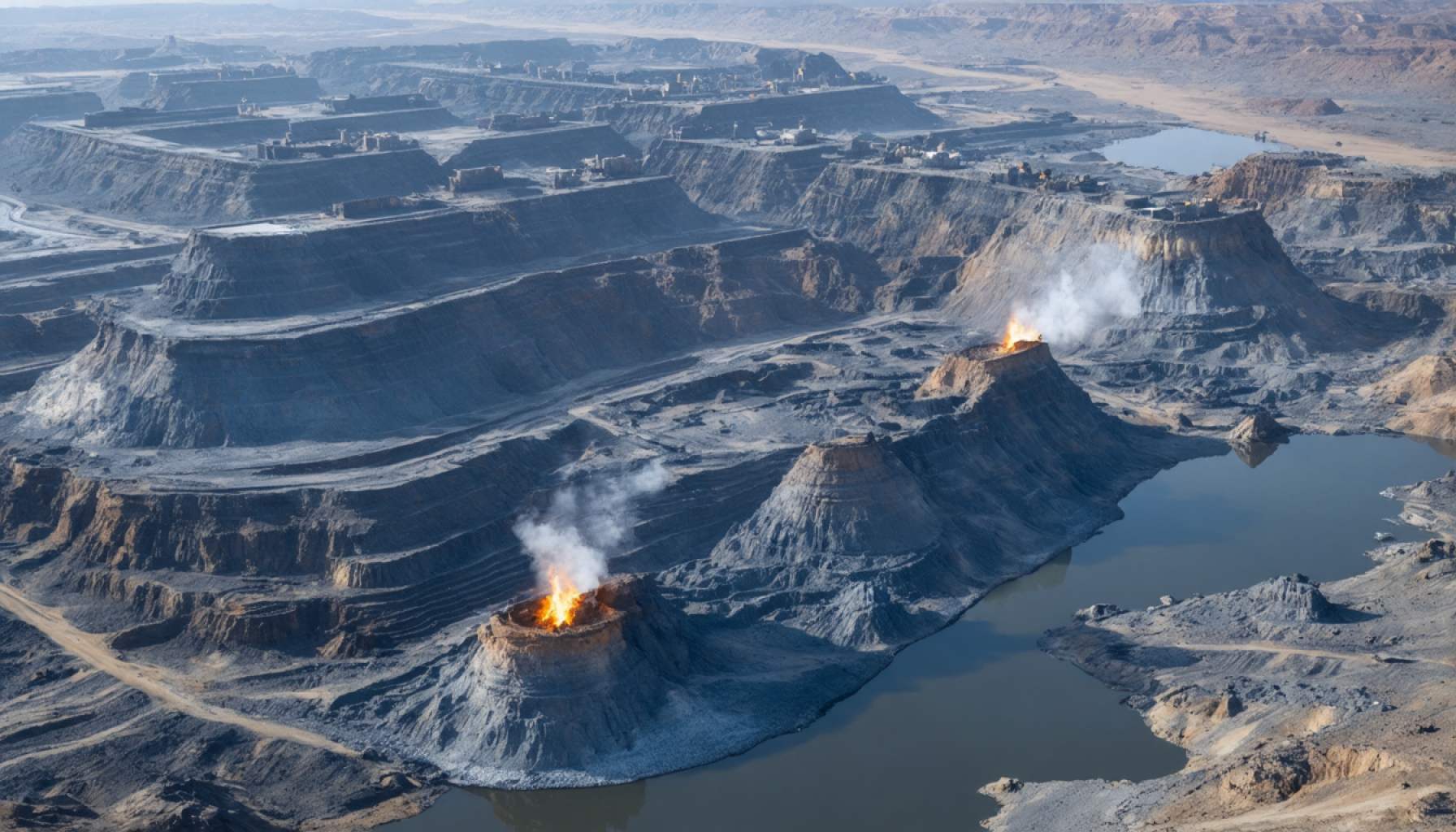- India is actively pursuing critical minerals like copper, lithium, nickel, and cobalt essential for renewable energy technologies.
- Africa, holding over 30% of the world’s critical mineral reserves, is a key partner in India’s strategy due to its rich mineral resources and long-standing trade ties.
- India’s investments in Africa exceed $75 billion, with bilateral trade nearing $100 billion, highlighting their robust economic relationship.
- The collaboration aligns with Africa’s Draft Green Minerals Strategy, focusing on sustainable development and mutual growth opportunities.
- India’s National Critical Minerals Mission aims to secure mineral supplies while contributing to Africa’s socio-economic advancement.
- Strategies include international collaborations, skill development, responsible mining standards, and leveraging technological expertise.
- The partnership envisions a future of shared prosperity and sustainable energy solutions, benefiting both regions economically and strategically.
Amidst the global clamour for sustainable and resilient energy systems, India is embarking on an ambitious quest to secure critical minerals crucial for its green transformation. Copper, lithium, nickel, and cobalt—the building blocks of renewable energy technologies—have become the new gold. With domestic reserves falling short, India is extending its gaze toward the mineral-rich soils of Africa.
Why Africa? This vast continent holds over 30% of the world’s critical mineral reserves, making it a focal point in the geopolitically charged arena of mineral diplomacy. As a long-standing trading partner with deep-rooted ties in African markets, India is not a newcomer to the region. New Delhi’s impressive investments exceeding $75 billion and bilateral trade nearing the $100 billion mark underscore the robust economic connection. Yet, the allure of Africa is not merely its abundance of resources but its aspirations for a mining renaissance that promises growth and development.
Charting Synergies
India’s approach is marked by a careful alignment of interests with African priorities. A tapestry of mutual goals emerges, woven from Africa’s Draft Green Minerals Strategy and the aspirations of nations eager to infuse sustainability into their development narratives.
For India, the strategic engagement in Africa offers a dual benefit: securing mineral supplies while contributing to the continent’s socio-economic fabric. The partnership promises a win-win, where India’s technological prowess and Africa’s mineral wealth can foster a future of shared prosperity.
The Roadmap
New Delhi’s National Critical Minerals Mission is the lodestar guiding these endeavors. It proposes robust frameworks to navigate the mineral landscape, advocating for international collaborations, advancements in mining technology, and a commitment to sustainable practices. By deploying the Geological Survey of India and extending support through an empowered committee, India aims to bolster its presence, marrying its need for resources with Africa’s development goals.
In the short term, India plans to establish a task force, perform skill needs analyses, and develop responsible mining standards. These actions are complemented by a vibrant exchange of knowledge, leveraging India’s educational and technological networks to build capacity and upskill local workforces.
Long-term strategies focus on strategic projects and private sector mobilization, which include the establishment of new exploration licenses and reimagining infrastructure projects with African visionaries.
A Sustainable Vision
This partnership visualizes a future where technology, responsible governance, and shared interests intertwine. It is an invitation to African nations to explore innovative avenues for growth while contributing to the global push for sustainable energy solutions.
The pathway forward is paved with opportunities for both India and Africa. Through leveraging each other’s strengths, the partnership not only aims to transform the energy landscape but also to signal a new era of economic collaboration. The takeaway is clear: in laying the groundwork for a sustainable future, the alliance between India and Africa may just light the way.
India’s Strategic Move: Tapping into Africa’s Critical Minerals for a Sustainable Future
Introduction
In the race for green transformation, securing critical minerals like copper, lithium, nickel, and cobalt is crucial for any nation aiming to bolster its renewable energy capabilities. India, recognizing the imperative need for these minerals to power its sustainable future, is turning to Africa—a continent rich in these resources. As global demand surges, India’s explorations form part of a broader, strategic partnership aimed at mutual growth and prosperity.
Why Africa is the New Frontier for Critical Minerals
Africa holds over 30% of the world’s critical mineral reserves, positioning the continent as an essential player in the mineral diplomacy arena. Historically, India has maintained strong economic relations with Africa, underpinned by investments exceeding $75 billion and bilateral trade nearing $100 billion. This existing relationship provides a solid foundation for India’s current endeavors.
Charting Strategic Synergies: India’s Approach
Aligning Interests with African Priorities
India is not simply extracting resources from Africa; it is partnering with African nations to weave a tapestry of mutual goals. Africa’s Draft Green Minerals Strategy aligns with India’s National Critical Minerals Mission, aiming to secure mineral supplies and bolster Africa’s socio-economic structure. This partnership promises technological sharing and development, creating a win-win situation.
The Roadmap Toward a Sustainable Partnership
India’s plan involves both immediate and long-term strategies, focusing on responsible and sustainable mining practices:
– Immediate Actions: Establishing a task force and developing responsible mining standards. India intends to perform skill need analyses, leveraging its educational networks to upskill local African workforces.
– Long-term Strategies: Mobilizing private sector involvement and strategic project planning, including new exploration licenses and infrastructure projects.
How-To Steps & Life Hacks
1. Educational Exchange: Foster student exchange programs to build technical expertise in mining and sustainable practices.
2. Technology Transfer: Use India’s technological advancements in mining to enhance African mining infrastructures.
3. Local Workforce Empowerment: Develop training modules to equip local communities with the skills needed for modern mining techniques.
Market Forecasts & Industry Trends
Cobalt, lithium, and nickel are expected to be the most sought after due to their essential role in battery technology:
– Cobalt: With electric vehicles becoming mainstream, the demand for cobalt is set to increase by 60% by 2025 (Source: International Energy Agency).
– Lithium: Projected to have a steady compound annual growth rate (CAGR) of 8.4% from 2020 to 2027 (Source: Allied Market Research).
Controversies & Limitations
While this Indo-African partnership holds promise, it faces challenges like resource nationalism, where countries tighten control over resources they regard as strategic. Moreover, sustainable mining practices must be ensured to minimize ecological impact.
Actionable Recommendations
1. Conduct Regular Audits: Maintain transparency in mining operations through periodic audits to ensure compliance with environmental standards.
2. Engage Local Communities: Include local stakeholders in planning to secure community buy-in and address social impacts.
3. Develop a Joint Research Initiative: Focus on innovations in sustainable mining practices utilized on a global scale.
Conclusion
India’s stride into Africa for critical minerals symbolizes a significant shift towards a greener, more sustainable future. Through strategic partnerships and responsible practices, this initiative not only aims to transform the energy landscape but also to forge a new era of collaboration and mutual prosperity.
For more insights into sustainable practices and collaborative strategies, visit International Energy Agency and Allied Market Research.














